Comparisons
Outline
Often times the easiest way to see what is missing is by comparing two subjects side by side. Here on the Comparison tab, we have done just that by presenting a brief overview of some notable differences, omissions and changes between the 1920 and 1962 Typical Editions of the Roman Missal.
Fr. Gregory Hesse also has an interesting lecture on the topic of the comparison between the Missal of Pius V (pre-55) and the Missal of 1962.
Additionally, New Liturgical Movement compiled this comparison between the rites in PDF form in this article.
General Changes regarding the Celebration of Mass
The Differences in the Ranking of Feasts and the Calendar
The traditional ranking of feasts is as follows:
- Duplex I Classis (Double of the I Class)
- Duplex II Classis (Double of the II Class)
- Duplex Maius (Double Major)
- Duplex (Minus) (Double (Minor))
- Semiduplex (Semi-Double)
- Simplex (Simple)
The traditional system of ranking feasts comes from the rules for the recitation of the Divine Office. Feasts that are ranked duplex or higher (duplex means double) have their antiphons recited in full before and after the psalm. The feasts below the rank of duplex would not have their antiphons recited in full before the psalm. Instead before the chanting of the psalm, the antiphon would be intoned only until the asterisk. After the psalm, the antiphon would be sung in full. John XXIII changed the rubrics in 1960 so that the antiphon was always repeated in full before all psalms, no matter their ranking of the feast. This is one of the reasons why the ancient ranking of feasts was removed under John XXIII. Since the ranking systems are vastly different, it is almost impossible to make a direct comparison between the ranking system of John XXIII and the ancient ranking system.
Mass and the Ranking of Feasts
The following are general rules for Masses based on the rank of the feasts they celebrate:
Duplex Feasts:
- One collect is said unless there is a commemoration.
- Gloria and Credo are sung according to rubrics.
Semiduplex and Simplex:
- Several Collects are to be made according to the rubrics.
- During octaves, the Mass is said of the feast day unless there is a proper Mass (such as Sundays within an octave).
Sundays
The ranking of Sundays is split into the ‘Greater Sundays’ and the ‘Lesser Sundays’. Greater Sundays are split into I and II Class.
Greater Sundays of the I Class are I Sunday of Advent, the four Sundays of Lent, Passion Sunday, Palm Sunday, Easter Sunday, Low Sunday, and Pentecost. These cannot be trumped by any feast. The Greater Sundays of the II Class are all the other Sundays of Advent and the three Sundays before the beginning of Lent. These are trumped by any feast of the rank of Duplex I Classis. All other Sundays are known as Lesser Sundays and are only trumped by feasts that are Duplex I or II Classis.
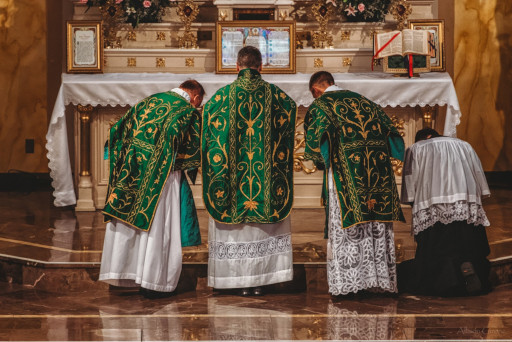
Green vestments in particular were rarely seen post-pentecost due to the great many saints, before Pius X
Before the reforms of Pius X, Sundays that were semiduplex were trumped by any feast that was Duplex or higher. The issue is that most saints have a feast day that is greater than semiduplex. This would have been acceptable in the times of Pius V when there were fewer canonised saints, however, by the reign of Pius X, the number of saints had increased, and it was possible that entire liturgical seasons could have passed without seeing a chasuble in the colour of the season. For this reason, Pius X raised Sundays to the practical rank of Duplex Maius which means that it could only be trumped by feasts of Duplex I or II classis. Since this was a practical elevation of rank and not a literal elevation, one can still see in Missals that these Sundays will retain the title ‘Semiduplex’ in their ranking.
Ferias
Ferias have a different ranking system in the pre-1960 rubrics.
Greater Privileged Ferias are ferial days which can never be impeded. These are: Ash Wednesday and Monday, Tuesday and Wednesday of Holy Week. No feast day could be celebrated on these days.
Greater Non-Privileged Ferias are ferias that hold the rank of simplex. These are the ferias of Advent, Lent & Passion Week, Rogation Monday and the Ember Days.
Octaves
The first day of an octave is called the feast day. The last day of an octave is called the ‘octave day’ and the days inbetween are called ‘days within the octave’. The ranking of these days vary depending on the type of octave. There are three ranks of octaves; privileged, common and simple.
Privileged Octaves came in three ranks. The first rank are those which feasts cannot be trumped for the entire octave. The octaves of Easter and Pentecost are of this rank. The second rank of Privileged Octaves include Epiphany and Corpus Christi. The octave days are duplex maius, and the days within the octave are semi-doubles, being displaced only by feasts of duplex I classis. The third rank of Privileged Octaves contains Christmas, Ascension and Sacred Heart. These days within the octave are trumped by any feast over simplex.
The first type of non-privileged octaves are the ‘Common Octaves’. The feasts that have a common octave are the Immaculate Conception, the Assumption, the Nativity of Saint John the Baptist, the Solemnity of St. Joseph, the feasts of Saints Peter and Paul, All Saints, and the principal patron saint of a church, cathedral, order, town, diocese, province, or nation. The days within the octave are simplex.
The last type of octave is the ‘Simple Octave’. This pertains to the feasts of Saint Stephen, Saint John the Evangelist, Holy Innocents, Saint Lawrence, the Nativity of the Blessed Virgin, and secondary patrons. The feast days themselves are duplex II classis, the octave day was a simple, and no days within the octave are commemorated.
St Joseph is not mentioned in the Canon Missae
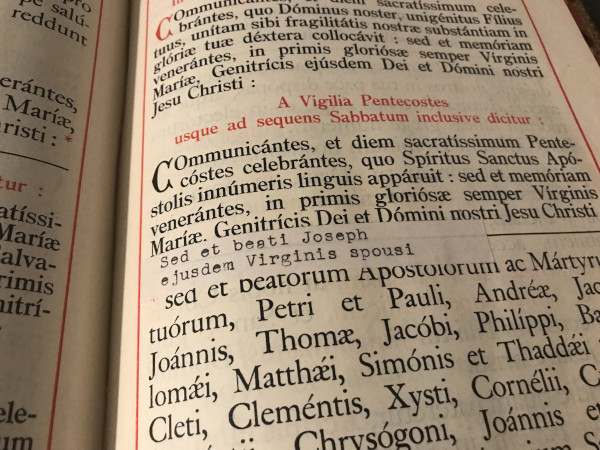
Example of missal mutilation common in the 1950s and 60s
John XXIII decreed on November 13, 1962 that the name of St Joseph should be added to the Canon of the Mass after the name of the Blessed Virgin. Missals were starting to be published prior to this decree which means that it may be possible to celebrate according to the 1962 Missal without the name of St Joseph in the Canon. The decree, however, came into effect on December 8th of the same year. If one does not have a pre-1962 Missal, then simply not saying ‘sed et beati Ioseph, eiusdem Virginis Sponsi’ will suffice.
The problem that many have with the insertion of St Joseph into the Canon Missae is that the Canon has remained untouched since antiquity. Pope Benedict XIV boasted that no one had added to the Canon Missae since Pope St Gregory the Great (540 - 604). Pope St Gregory collated what he had at the time and added the ‘diesque nostros in tua pace disponas’ to the Hanc Igitur. The problem is more on a matter of principle than of preference.
The Mandatory use of Multiple Collects
Most of the rules for collects are the same between the 1962 and pre-1962 Missals. However, there are a few changes. On certain ranks of feasts, extra collects are mandatory. These can be found in a certain part of the Missal called the Tabula Orationum. The following are general rules taken from the General Rubrics found in the 1920 typical edition of the Missale Romanum.
Sundays
On Sundays three Collects are said, as assigned in the Ordinary, except on the Sundays otherwise noted.
Semiduplex
On Semidouble Feasts occurring from the Octave of Pentecost until Advent, and from the Candlemas until Lent, the second Collect is A cunctis, and the third ad libitum.
On Semidouble Feasts occurring from the Octave of Epiphany until Candlemas, the second Collect is Deus, qui salútis, and the third Ecclésiæ tuæ or Deus, ómnium fidélium for the Pope.
On Semidouble Feasts from Ash Wednesday until Passion Sunday, the second Collect is of the Feria, and the third A cunctis.
On Semidoubles from Passion Sunday until Palm Sunday, the second Collect is of the Feria, and the third Ecclésiæ tuæ or for the Pope.
On Semidouble Feasts from the Octave of Easter until Ascension, the second Collect is Concéde nos of Our Lady, and the third Ecclésiæ tuæ or for the Pope.
On Semidouble Feasts occurring within Octaves, the second Collect is of the Octave, and the third is the one placed in second place within the Octave.
During Octaves
During the Octaves of Easter and Pentecost, on Masses of the Octave only two Collects are said, one of the day, and the second Ecclésiæ tuæ or for the Pope.
During other Octaves, and on fasting Vigils (except the Vigil of Christmas and of Pentecost), three Collects are said, one of the day, the second of Our Lady, and the third Ecclésiæ tuæ or for the Pope.
But during Octaves of Our Lady, and on the Vigil and during the Octave of All Saints, the second Collect is Deus, qui corda of the Holy Ghost, and the third Ecclésiæ tuæ or for the Pope.
On Sundays occurring within Octaves two Collects are said, one of the Sunday, and the second of the Octave. On the Octave day, only one Collect is said, unless another commemoration is made.
Simplex and Feria
On Simple Feasts and Ferias per annum, unless otherwise noted three Collects are said, as on Semidoubles, or five, or even up to seven ad libitum.
The use of the Biretta
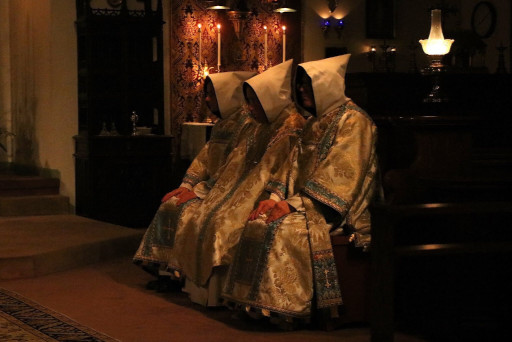
At the start of Mass, it is common in most places that the celebrant processes to the altar while wearing a biretta. Places that have friars or monks will sometimes see that the celebrant will wear a hood or capuce in place of the biretta. This is of ancient origin and the reason why the amice is first touched to the head prior to being worn around the shoulders and neck. The origin of the removal of the biretta for Mass comes from the 1962 Missale Romanum.
Prior to the 1962 edition, the Ritus Servandus had always stated:
“Sacerdos, omnibus paramentis indutus, accipit manu sinistra Calicem, ut supra praeparatum, quem portat elevatum ante pectus, Bursam manu dextera super Calicem tenens, et facta reverentia Cruci, vel imagini illi, quae in Sacristia erit, capite cooperto accedit ad Altare, ministro cum Missali et aliis ad celebrandum necessariis (nisi ante fuerint praeparata) praecedente, superpelliceum induto.”
However the 1962 Roman Missal, one finds the following:
“Sacerdos, omnibus paramentis indutus, accipit manu sinistra calicem, ut supra praeparatum, quem portat elevatum ante pectus, bursam manu dextera super calicem tenens, et facta reverentia Cruci, vel imagini illi, quae in Sacristia erit, accedit ad altare, ministro cum missali et aliis ad celebrandum necessariis (nisi ante fuerint praeparata) praecedente, superpelliceum induto.”
The complete omission of the phrase “with covered head” is interpreted by most to mean that the use of the biretta is not required at Mass and therefore should be omitted. However, some rubricians stress that this is a relaxation and not a ban on the biretta. On the contrary, most tend to interpret the omission in the text as meaning the omission of the biretta for Mass.
The Proper Last Gospel
It is a modern innovation to have only the prologue of St John at the end of every Mass. Prior to 1955, the Last Gospel was used to commemorate feasts. Prior to the Pacellian reforms, the Last Gospel was used when the Mass of a Feast superseded either a Sunday Mass, Vigil or Feria of Lent. An example of this would be if St Michael were to land on a Sunday, then the Michaelmas was celebrated with the Last Gospel being the Gospel of the Sunday. In this way, the Sunday is commemorated by a Collect, Secret, Postcommunion and Gospel. Another example of a Proper Last Gospel would be on the third Mass of Christmas. The Gospel of the Mass is John 1:1-14, therefore the Missal says that the Gospel of Epiphany is said in place of the Last Gospel. A liturgical ordo is quite good in that it will point out when the Last Gospel changes.
Bows towards the Crucifix
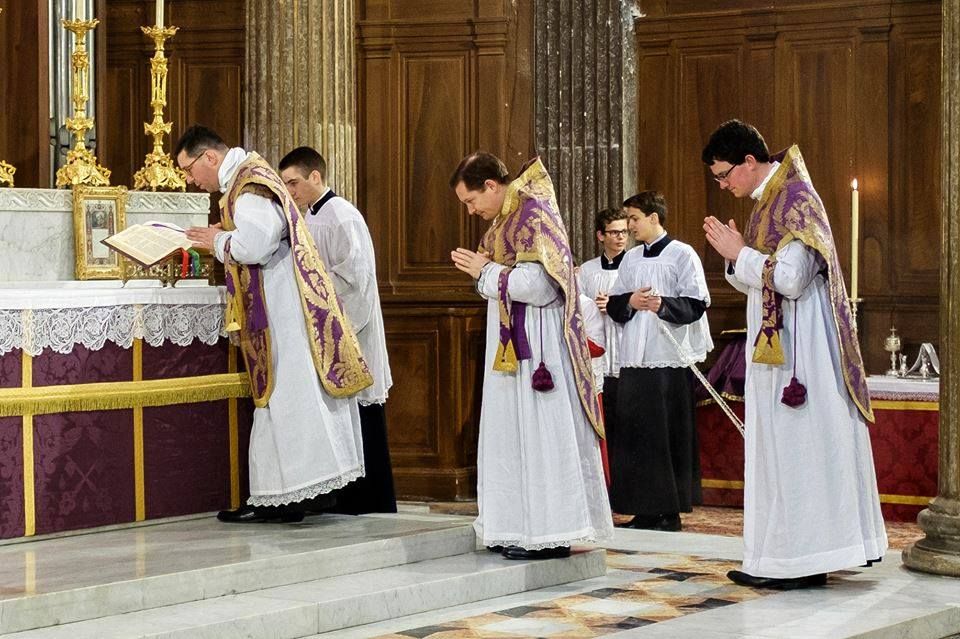
The rubrics for the Missal of 1962 omit the line that says that some bows are made to the crucifix rather than to the book. This includes the Holy Name (which is found mostly during the closing of prayers), the Gloria Patri and the name of the saint on their feast day. The traditional rule is that at any mention of the Holy Name and the first half of the Gloria Patri the celebrant is to bow towards the altar cross. There are also other bows towards the cross at a Trinitarian formula but the Gloria Patri is the most common. At any mention of Our Lady or a saint on their feast day, a bow is made towards an image of the saint if it is set above the altar. If not, a bow to the book is made. All liturgists interpret this omission as a simple bow to the book instead of the traditional bow to the altar crucifix or image.
The Johannen Missal mentions it as follows:
“Cum in oratione, vel alibi in Missa, pronuntiatur nomen IESU vel MARINE, itemque cum exprimitur nomen Sancti vel Beati de quo dicitur Missa aut fit commemoratio, vel Summi Pontificis, sacerdos caput inclinat. Si plures orationes sint dicendae, idem in eis, in voce, extensione manuum, et capitis inclinatione, quod supra dictum est, observatur.”
On the converse, the Missal of Pius V states the following:
“Cum nominatur nomen JESUS, caput versus Crucem inclinat: quod etiam facit cum nominátur in Epistola. Et similiter ubicumque nominatur nomen B. Mariæ, vel Sanctorum de quibus dicitur Missa, vel fit Commemoratio: item in Oratione pro Papa, quando nominátur, semper caput inclinat, non tamen versus Crucem; nisi in loco principali Altaris habeatur simulacrum vel imago B. M. V. aut Sancti, ad quam caput inclinatur. Si plures Orationes sint dicendæ, idem in eis, in voce, extensione manuum, et capitis inclinatione, quod supra dictum est, observatur.”
Confiteor before the Communion of the Faithful
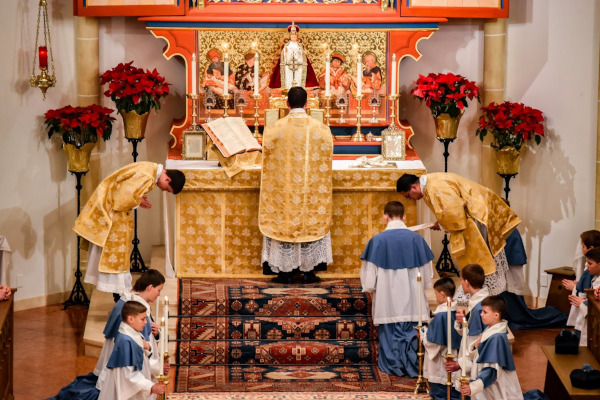
In the Missal of John XXIII, the confiteor before Holy Communion was removed. However, it did remain in the Pontificale Romanum in force in the same year. This is another practice that is commonplace in the Masses said according to the Missal of 1962, but should be omitted if one is to follow the rubrics of the same book. The confiteor is to be sung at Solemn Masses by the Deacon and recited by the servers at Sung and Low Masses.
This is an extract from the Missale Romanum of 1962:
“Si qui sum communicandi in Missa, paulo antea ministrans campanulas signo eos moneat. Sacerdos autem, post sumptionem Sanguinis, calicem parum ad latus Evangelii collocat, intra tamen corporate, et palla tegit. Deinde, si particular super corporate consecratae sint, facta genuflexione, eas super patenam ponit; si particulae in eadem Missa intra pyxidem consecratae sunt, pyxidem collocat in medio corporali, earn discooperit et genuflectit; si vero administrandae sunt particulae iam antea consecratae, aperto tabernaculo, genuflectit, pyxidem extrahit et discooperit. Postea accipit manu sinistra pyxidem seu patenam cum Sacramento, dextera vero sumit unam particulam, quam inter pollicem et indicem tenet aliquantulum elevatam super pyxidem seu patenam, et, conversus ad communicandos in medio altaris, dicit: Ecce Agnus Dei, ecce qui tollit peccata mundi. Deinde dicit: Domine, non sum dignus, ut intres sub tectum meum, sed tantum die verbo, et sanabitur anima mea.”
In the Missale Romanum of 1920, the confiteor before Holy Communion can be seen:
“Si qui sunt communicandi in Missa, Sacerdos post sumptionem Sanguinis, antequam se purificet, facta genuflexione, ponatparticulas consecratas in Pyxide, vel, si pauci sint communicandi, super Patenam, nisi a principio positae fuerint in Pyxide seu alio Calice. Interim minister ante eos extendit linteum seu velum album, et pro eis facit Confessionem dicens: Confíteor Deo, etc. Tum Sacerdos iterum genuflectit, et manibus junctis vertens se ad populum in cornu Evangelii, dicit: Misereátur vestri, et Indulgéntiam, absolutiónem, et remissiónem peccatórum vestrórum, etc., et manu dextera facit signum crucis super eos. Postea genuflectens, accipit manu sinistra Pyxidem seu Patenam cum Sacramento, dextera vero sumit unam particulam, quam inter pollicem et indicem tenet aliquantulum elevatam super Pyxidem seu Patenam, et conversus ad communicandos in medio Altaris, dicit: Ecce Agnus Dei, ecce, qui tollit peccáta mundi. Deinde dicit: Dómine, non sum dignus, ut intres sub tectum meum, sed tantum dic verbo, et sanábitur ánima mea.”
The Sanctus Candle
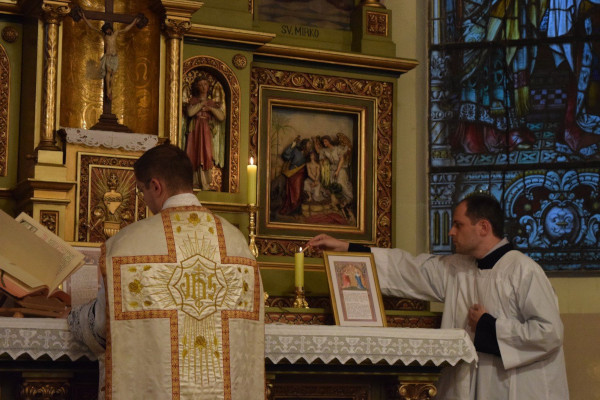
Sanctus candle being lit at the beginning of the canon
The Sanctus Candle is the name given to a small candle that is on the epistle side of the altar in between the tabernacle and the Low Mass candle on that side.1 The Sanctus Candle is lit from the Sanctus until the end of the ablutions.
Although the use of a Sanctus Candle is often neglected, it is still found in the rubrics of the Roman Missal and mentioned by most liturgical commentators.2 3 4
The Sanctus Candle is not used at Solemn Masses as the torchbearers are present. It is a common practice that at Sung Masses, where there are no torchbearers, the Sanctus Candle is lit at the usual time and in the usual manner. However, in places where the custom has never existed, one is not obliged to have the Sanctus Candle.5
Specific Changes regarding Low, Sung and Solemn Masses
Low Mass – Missa Lecta / Missa Privata
Celebrant:
- Use of biretta.
- Bows towards the crucifix.
- Absolution after the server’s Confiteor prior to Communion of the faithful.
- Possible proper Last Gospel.
Server:
- Use of the Sanctus Candle.
- Confiteor prior to Communion of the faithful.
- Use of the Missal at the end of Mass if there is a proper Last Gospel.
Sung Mass - Missa Cantata
Celebrant:
- As stated above.
- Gloria and Credo are recited while the choir sings them. After this, the Celebrant is to sit at the sedilia. The Celebrant is not to sing these with the choir.
Thurifer:
- Prior to 1962, the use of incense at a Sung Mass required an indult from Rome. Many places were grated indults for the use of incense at Mass. Permission was given for all Sung Masses in the 1960 rubrics.
- The Celebrant is to be incensed.
Acolytes:
- Use of a Sanctus candle if there are no torchbearers.
Master of Ceremonies:
- Recitation of the Confiteor prior to Communion and the use of the proper Last Gospel.
Solemn High Mass - Missa Solemnis
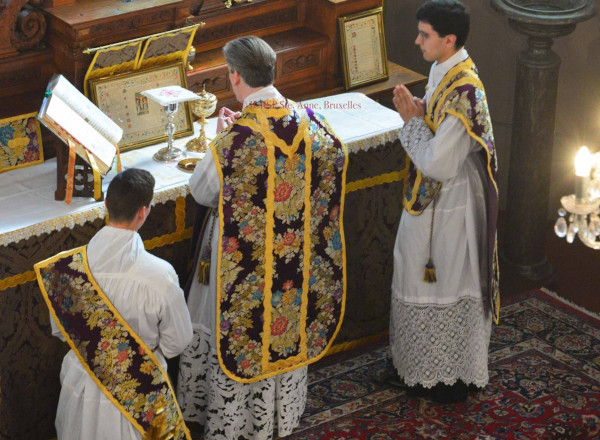
An example of subdeacon in folded chasuble, and deacon in broad-stole
Celebrant:
- As aforementioned.
- The recitation of the Epistle and Gospel.
Deacon:
- After the oratio has been sung, the deacon is to stand next to the celebrant as he recites the Epistle and responds ‘Deo gratias’ when completed.
- Folded chasuble and broad stole are worn in penitential times.
- Confiteor is sung prior to the distribution of Holy Communion to the faithful.
Subdeacon:
- Use of the folded chasuble in penitential times
- This is taken off temporarily for the singing of the Epistle.
- Assist with the recitation of the Gospel prior to its singing.
- Respond ‘Laus Tibi, Christe’ when finished the Gospel has been recited by the celebrant.
- Moving of the Missal if there is a proper Last Gospel.
Master of Ceremonies:
- No need to respond ‘Deo gratias’ or ‘Laus Tibi, Christe’ at the singing of the Epistle or Gospel as this is done by the Deacon and Subdeacon at the recitation.
The Pacellian ‘Reforms’ of Holy Week
The new rite of Holy Week was created and made optional in 1951 and then made mandatory in 1955. The ceremonies were written up by the architect of the Novus Ordo Missae, Annibale Bugnini.6
Palm Sunday
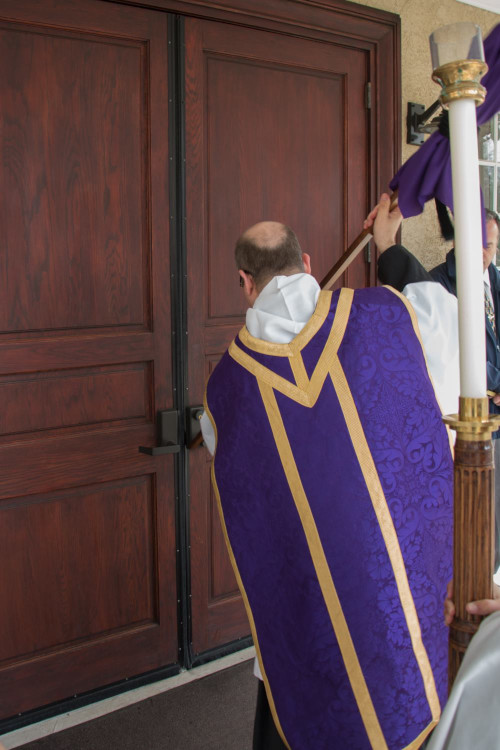
Most of the changes for Palm Sunday were in regard to the ceremonies that precede the Mass. One of the major differences is the removal of the Missa Sicca (Dry Mass). This was a relic of a Mass that included the blessing of the palms. Traditionally, an important blessing was not done simply with an Oremus and a few signs of the cross. An important blessing was done with a consecratory preface. This means that it started with ‘Dominus Vobiscum. Et cum spiritu tuo. Sursum corda’ etc. This is seen most evidently in the Sacrifice of the Mass with the consecration of the Host beginning with the Preface prior to the Canon Missae. It is also seen in the old consecration of the Paschal Candle according to the pre-1955 books. Further, it is seen in the Missal of 1962 in the blessing of Epiphany and Paschal Water as well as the ordination of a priest. The consecratory ceremonies and preface for the blessing of palms were removed by Pius XII and all that remains is a simple ‘Oremus’ with only one of the prayers.
Another odd change was that the colour of the procession changed from violet to red. Processions were traditionally seen as penetiental, hence why most processions are done in violet. For Palm Sunday, this was because it was the day when Jesus processed to Jerusalem where he was to be slain on the cross. It is a time of mourning, hence the use of violet. Also in the procession was the use of the folded chasuble by the Deacon and Subdeacon. This is another aspect of the mourningful nature of the procession. The use of red for the blessing and procession makes no sense as red had been liturgically reserved for days on which martyrs have died as well as Pentecost. Why would red be used when Jesus had not yet been martyred? Also used in the post-1955 Palm Sunday are the tunicle and dalmatic, the two vestments of joy. Palm Sunday was not a day of immense joy, but rather the beginning of the great sorrowful sacrifice of God on the cross. For this, such symbolism of joy seems quite inappropriate.
Maundy Thursday
Relatively little was changed in the liturgy of Maundy Thursday. The biggest change from the Pacellian Reforms was the mandatory use of the Mandatum and its place after the homily at Mass. All of the other reforms were due to the removal of the Mass of the Presanctified on Good Friday.
| Pre-1955 | 1955 |
|---|---|
| - The Mandatum (washing of feet) is a separate ceremony that takes place outside of Mass. It is also not to be done in the sanctuary. | - The Mandatum is to happen right after the homily and in the sanctuary. |
| - A second Host is consecrated for the Mass of the Presanctified. This is then put into a chalice and processed to the altar of repose. | - There is no consecration of a second large Host. The laity are to commune from a ciborium. |
| - The procession has two thurifers walking backwards (in some places) incensing the Blessed Sacrament. | - The procession only has one thurifer. |
| - Communion is distributed from Hosts consecrated at any Mass. | - Communion is distributed from Hosts consecrated at the Mass of Maundy Thursday. |
| - At the stripping of the altars, the veiled cross remains with two candlesticks. | - At the stripping of the altars, the cross and candlesticks are removed, Thus leaving everything bare. |
| - Vespers is sung right after Mass. | - Those who attend the liturgy are dispensed from Vespers. |
Good Friday
The changes of the liturgy of Good Friday are the most grievous of the entire Holy Week ‘reform’ of 1955. The Pacellian Reform removed the only Mass of the Presanctified left in the Latin Church. The traditional understanding of Good Friday was that it was a Mass of the Presanctified which means it was a ceremony that had the character of Mass but with a Host consecrated at a previous Mass. The ceremony retained the nature of a Mass as seen by the use of the chasuble and maniple, the vestments that can only be worn within Mass and nowhere else. The ceremonies are ancient in origin with prayers taken from the Mass itself as well as having an elevation of the Host.
However, the 1955 reforms turned the liturgy of Good Friday into a Liturgy of the Word and Liturgy of the Eucharist. The ancient prayers that called upon the sacrifice of Calvary and the actions associated with them were exchanged for a simple Communion service. The procession of the Blessed Sacrament that calls to mind the procession of Christ to stand before Pilate had lost its dignity and honour. This is by far the day that received the most destruction by the Pacellian ‘reform’ of Holy Week.
| Pre-1955 | 1955 |
|---|---|
| - Called: “Mass of the Presanctified” or “Feria Sexta in Parasceve”. | - Called: “Solemn Liturgical Action” or “Commemoration of the death of Our Lord Jesus Christ.” |
| - Crucifix and candlesticks are on the altar. | - The altar is entirely bare. |
| - The Celebrant in a black chasuble, and Deacon and Subdeacon in folded chasubles, prostrate themselves before the altar. In the meantime, a single cloth is spread upon the altar | - The Sacred Ministers wearing only albs and stoles prostrate themselves before the altar. The altar is dressed at a later moment.' |
| - The celebrant always wears a chasuble. The sacred ministers will eventually wear maniples. | - The priest changes between black chasuble and cope. The sacred ministers eventually change into violet vestments. |
| - The Gospel is distinct from the Passion. | - The Passion is the Gospel of the ceremony. |
| - Seventh oration is entitled “For Heretics and Schismatics” | - Seventh oration is entitled “For the unity of the Church.” |
| - No kneeling for the oration for the Jews. | - Kneeling at the oration for the Jews. |
| - The crucifix is removed from the altar and laid upon a violet cushion on the bottom step of the altar and is venerated by ministers and clergy. | - The crucifix is processed from the sacristy and held by two acolytes at the footpace to be venerated by the ministers and clergy. |
| - The procession is done in black vestments. | - The procession is done in violet vestments. |
| - The Blessed Sacrament is processed from the altar of repose to the High Altar. The Vexilla Regis is sung at this point. | - The procession is downplayed in the Pacellian reforms. |
| - The procession has two thurifers walking backwards incensing the Blessed Sacrament. | - There is only one thurifer incensing during the procession. |
| - After the Blessed Sacrament returns to the High Altar, the Sacred Ministers prostrate themselves down to the earth in a genuflection while in plano. Then the Blessed Sacrament is incensed while in plano. | - The incensation of the Host and the double genuflection are suppressed. The incensation of the altar is suppressed |
| - Then the Victim and altar are incensed in the usual manner as at Mass. | - The elevation of the Host was suppressed. |
| - Just as Jesus was raised upon the cross, the priest takes the Host and raises it up with one hand for the faithful to see. | - The Orate Fratres is suppressed as are most of the prayers mentioning the sacrifice. |
| - The Orate Fratres is said without a response. The prayers that follow make reference to the sacrifice. | - The Pater Noster is recited by everyone present. |
| - The Pater Noster is recited by the priest alone. | - There is no placing for the fraction of the Host in the chalice. |
| - A fraction of the Host is placed into the chalice. | - Holy Communion is offered to all. |
| - Only the priest is to commune on Good Friday. | - Those who attend the ceremony are dispensed from Vespers. |
| - Vespers is sung directly after the Mass of the Presanctified. |
Easter Vigil
This is the second time in the ‘reforms’ that a consecratory preface was removed from the liturgy. The very text of the Exultet speaks of the consecration of the candle when it is proclaimed. Pius XII removed this consecratory preface and asked that the priest bless (not consecrate) the candle with a newly created prayer instead of the consecratory preface. Also, the very ancient triple candle was removed with the swipe of a pen. This was an ancient symbol that symbolises the light borne by the Holy Trinity descending upon the world. In its place, the paschal candle is used. One thing that was an innovation and not a restoration was the removal of the prayers at the foot of the altar prior to Mass. The idea was that since there were ceremonies happening prior to the beginning of the Mass, the Sacred Ministers should just be able to assemble for the introit.
| Pre-1955 | 1955 |
|---|---|
| - The fire is to be started with flint. | - The fire is to be lit in whatever manner prior to the starting of any ceremonies. |
| - The Paschal Candle stands unlit in the sanctuary. | - The Paschal Candle is blessed outside the church. |
| - The fire and grains of incense are blessed outside the church. The fire is then given to the tricereo, the rod that holds three candles. | - The candle is used to carry the flame to the sanctuary. |
| - At Lumen Christi, all genuflect to the flame. The flame is then held in the sanctuary on the tricereo and is not passed to the Paschal Candle. | - At Lumen Christi, all genuflect to the candle. And then it is placed in the sanctuary. |
| - The Exultet begins with the candle unlit and the grains of incense are inserted at certain points. | - The Exultet begins with the candle already lit. It is more of a proclamation than the traditional diaconal consecration of the candle. |
| - Twelve lessons are sung. | - All but four of the twelve lessons remain. |
| - The litany is sung after the blessing of the paschal water. | - The litany begins after the lessons, then there is a pause for the blessing of paschal water, then it continues. |
| - The litany is doubled such that it is as follows: | - The litany is not doubles such that it is as follows: |
| - Cantors: Pater de caelis Deus, miserere nobis. | - Cantors: Pater de caelis Deus, |
| - People: Pater de caelis Deus, miserere nobis. | - People: miserere nobis. |
| - The water is blessed at the font, which is at the front of the church, before the nave. It is after this that the catechumens are baptised and allowed to enter into the church. | - The water is blessed in the middle of the sanctuary facing the people the entire time. |
| - Never existed. | - Creation of the renewal of baptismal promises and the recitation of the Our Father by everyone. |
| - Mass begins with the prayers at the foot of the atar. | - Prayers at the foot of the altar are omitted. |
| - Mass ends with a contracted form of Vespers. | - Mass ends with a contracted form of Lauds. |
Concluding Thoughts
The foregoing summary attempts to do several things.
The first is to make evident that there are few priests who celebrate the Mass in exact correspondence to the rubrics and ceremonies of the 1962 Missal. For instance, the bowing to the crucifix at mentions of the Holy Name is followed in most places.
Second, it provides an overview for priests who wish to start celebrating Mass according to the pre-1962 Missal and do not know what the difference would be. It also offers a brief guide by which servers at the altar can be aware of the differences.
Third, it shows that the deep cuts and modifications of Holy Week are part of the downfall of liturgy in the 20th century. Given what happened, how can we avoid asking the question: Why should Holy Week ceremonies that were in use for only approximately 14 years be more important or binding than the rites of Holy Week that the Church throughout the West observed for so many centuries, even in some respects back into antiquity? Unquestionably the pre-55 Holy Week has the first claim on our allegiance as Catholics who love the Latin liturgical tradition of the Church.
This summary has been limited to some obvious elements of reform found in the 1962 Missal. There are many other elements worthy of discussion (Vigil of Pentecost, folded chasubles, variance of proper texts and liturgical colours of feasts, etc.) that we hope to expand upon in due course. We, as Catholics attached to the traditional rites of Holy Mother Church, are becoming more conscious of the great loss of beauty and symbolic integrity in the twentieth century reforms proof to the Second Vatican Council. Let us earnestly pray for the restoration and liberation of the Classical Roman Rite as known, loved and prayed by countless Saints, Martyrs and Faithful from time immemorial.
-
Rubricae generales Missalis Romani, § 20. ↩︎
-
Ibidem. ↩︎
-
Adrian Fortescue, The Ceremonies of the Roman Rite Described (London: Burns, Oats & Washbourne, 1920) 79. ↩︎
-
Josephus Van Der Stappen, Sacra Liturgia: Ad Usum Alumnorum Seminarii Archiepiscopalis Mechliniensis (Mechelen: Dessain, 1904) 100 – 102. ↩︎
-
Sacred Congregation of Rites, 9 June 1899. ↩︎
-
May his bones be crushed. ↩︎